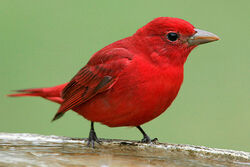| Summer Tanager | |
|---|---|
 male | |
| Scientific classification | |
| Kingdom: | Animalia |
| Phylum: | Chordata |
| Class: | Aves |
| Order: | Passeriformes |
| Family: | Cardinalidae |
| Genus: | Piranga |
| Species: | Piranga rubra |
The Summer Tanager (Piranga rubra) is a member of the family Cardinalidae. The breeding habitat is open wooded areas, especially those with oak trees, across the Southern United States. The migration range spans Central America, Mexico, and northern parts of South America. It has been witnessed in Europe, though, sightings in that region are extremely rare.
Appearance[]
Summer Tanagers are medium-sized birds, though, rather large in comparison to other tanagers. They can be up to 17 cm long, with an average weight of 30 g. The male is a rose red. The female is olive above and orange-yellow below, and some females have been known to develop male pigmentation as they age. Juvenile Summer Tanagers resemble adult females, but the male often develops patches of red during its first winter.
Behavior[]
At the beginning of the breeding season, males sing and chase each other vigorously to define territorial boundaries. Each male has only one mate per breeding season. The female incubates the eggs by herself while the male forages, preens, and rests. In some breeding pairs, but not all, the male brings food to his incubating mate. However, all males seem to bring food on the day the chicks hatch, and the parents share feeding duty for the nestlings. When the young leave the nest at about 10 days old they are barely able to fly, so they take cover in vegetation and beg for food by calling periodically. Their parents feed them for at least three weeks after they fledge. Breeding tanagers are parasitized by cowbirds (which lay eggs in their nests) and aggressively chase these intruders from nesting areas. Outside of the breeding season, Summer Tanagers are usually solitary, although they sometimes follow mixed-species flocks of fruit-eating birds on their wintering grounds.
Nesting[]
The nest is usually within a cluster of leaves or a fork of branches overhanging a road, creekbed, or treefall gap in the forest.
The female gathers the nest material and builds the nest by herself, though the male may accompany her as she moves back and forth. Using dried grasses and other herbaceous vegetation, she weaves a crude cup measuring about 3.5 inches across and 2 inches high on the outside, with an inner cavity about 1 inch deep and 3 inches across.
The clutch size of Summer Tanagers are from 3 to 4 eggs and 1 to 2 broods are raised every year.
Distribution and Habitat[]
Summer Tanagers breed in gaps and edges of open deciduous or pine-oak forests across the southern and mid-Atlantic U.S. In the Southwest they breed in low-elevation willow and cottonwood woodlands, and in higher-elevation mesquite and saltcedar stands. During migration, Summer Tanagers stop in habitats similar to those of their breeding range, as well as parks, gardens, and beach ridges. They spend the winter in many types of open and second-growth habitats in southern Mexico, Central America, and northern South America.

Female Summer Tanager


